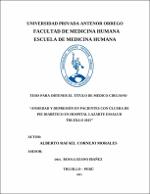Ansiedad y depresión en pacientes con ulcera de pie diabético en hospital Lazarte EsSalud Trujillo 2015

Ver/
Descargar
(application/pdf: 483.5Kb)
(application/pdf: 483.5Kb)
Fecha
2016Autor(es)
Cornejo Morales, Alberto Rafael
Metadatos
Mostrar el registro completo del ítemResumen
Evaluar si los desórdenes de ansiedad y depresión están
asociados a la úlcera del pie diabético en pacientes atendidos en el Hospital
Víctor Lazarte Echegaray de Trujillo durante el periodo de Enero a Febrero del
2015.
MATERIAL Y MÉTODO: Realizamos un estudio observacional, analítico,
de cohortes, que evaluó 162 pacientes con diabetes mellitus t ipo 2 ≥ 45 años de
edad distribuidos en dos grupos (Cohorte I: 81pacientes con ulcera de pie
diabético y Cohorte II: 81 pacientes sin esta condición) que acudieron para
algún control.
RESULTADOS: La edad promedio de los pacientes de la cohorte I fue 64,31 ±
5,65 años y de la cohorte II fue 64,17 ± 5,95 años (p > 0,05); la proporción de
varones en la cohorte I y II fueron 77,78% y 67,90% respectivamente (p >
0,05). El tiempo del diagnóstico de la enfermedad promedio en la cohorte I fue
12,01 ± 4,19 años y en la cohorte II fue 9,22 ± 3,98 años (p < 0,001). La
incidencia de ansiedad fue 51,85% en los pacientes con ulcera en el pie
diabético y 14,81% en los pacientes sin ulcera, con un RR 3,50 IC 95% [1,99 –
6,14] (p < 0,001) y la incidencia de depresión en los pacientes con y sin ulcera
en el pie diabético fueron 24,69% y 7,41% respectivamente; obteniéndose un
RR 3,33 IC 95% [1,41 – 7,87] (p < 0,01).
CONCLUSIONES: Los pacientes con ulcera en el pie diabético tuvieron altas
tasas de incidencia de ansiedad y depresión estadísticamente significativas. To assess whether anxiety disorders and depression are
associated with diabetic foot ulcers in patients treated at the Victor Lazarte
Echegaray Trujillo Hospital during the period from January to February 2015.
MATERIAL AND METHODS: We conducted an observational, analytical,
cohort study, which evaluated 162 patients with diabetes mellitus t ype 2 ≥ 45
years of age divided into two groups (Cohort I: 81pacientes with diabetic foot
ulcer and Cohort II: 81 patients without this condition) who attended for some
control..
RESULTS: The mean age of patients in the cohort I was 64.31 ± 5.65 years
and the Cohort II was 64.17 ± 5.95 years (p > 0.05); the proportion of males in
the cohort I and II were 77.78% and 67.90% respectively (p > 0.05). The time
mean of diagnosis of the disease in the cohort was 12.01 ± 4.19 years and the
cohort II was 9.22 ± 3.98 years (p < 0.001). The incidence of anxiety was
51.85% in patients with diabetic foot ulcer and 14.81% in patients without
ulcer, with a RR 3.50 95% CI [1.99 to 6.14] (p < 0.001) and the incidence of
depression in patients with and without diabetic foot ulcer were 24.69% and
7.41% respectively; with a RR 3.33 95% CI [1.41 to 7.87] (p <0.01).
CONCLUSIONS: Patients with diabetic foot ulcer had higher incidence rates
of anxiety and depression statistically significant.
Palabras clave
Colecciones
- Medicina Humana [3196]

